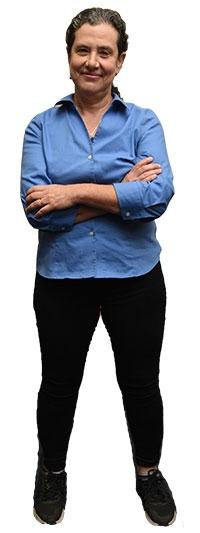Gloria Weiss has worked for 20 years at the Consortium for Worker Education (CWE), the workforce development arm of the New York City Central Labor Council. The nonprofit’s 170 teachers and paraprofessionals joined the UFT in 1993.
What made you choose this career?
I was teaching pre-K at a public school in Manhattan when I heard about CWE and decided to substitute teach a class there and fell in love with working with the adult ed population! My grandmother, who I was so close to, came to this country at 13 from Poland and took ESL classes when she arrived. I always thought my grandmother was the smartest person I knew and she had a 3rd-grade education, so I knew that having an advanced degree doesn’t define a person’s intelligence. The CWE students were so grateful and so appreciative of the teachers and what they were learning. It felt like giving back, because I knew my grandmother had started this way.
Who have you taught over the course of your 20 years at CWE?
I began by teaching ESL to garment workers. I have also taught math to workers on track to become carpenters and math and science for green jobs. I now teach high school equivalency for the TASC exam to 1199 SEIU members in the health care field.
How is teaching adults different from teaching children?
Adults are choosing to come to the program and often they’ve already experienced difficulties in life and realize that they need the class to keep, upgrade or get a job. I’m teaching toward a test, the TASC, which replaced and is more challenging than the GED. My students may have been working for 10 years as certified nurses’ assistants in nursing homes or hospitals, and if they don’t get their high school diploma, they could lose their job. So the stress level for the students is so high and for me as their teacher as well, because I want to see them accomplish their goals.
What kind of students do you work with?
My students come from different countries and backgrounds, with very mixed levels of skills. Most are middle-aged, with children and elderly parents, and they are trying to balance going to class and doing homework while juggling these other demands. It’s plain-out exhausting.
Tell me about your classes and your teaching philosophy.
My classes range from 12 to 25 students. I try to create a sense of community. Some students are very anxious; they’ve been out of school for many years. I have them work in groups or pairs, and I’ll tell them, “I’m your coach, but not your only coach.” Students help each other master skills.
I get to teach all the major subjects — social studies, science, reading, writing and math. I try to find readings that engage the students. The Civil War is a high-emphasis topic on the test, so we look at current events like the protests about the Confederate statues.
What is your work week like?
I’m one of only 18 full-time teachers in the program. The rest are part-time. I teach at two sites: one in the Bronx and one in Manhattan. I teach one three-hour class a day, as well as tutor at the learning center in TASC, pre-college and ESL.
How does being a UFT member make your job more doable and satisfying?
I’m passionate about social and economic justice issues. I understand why unions developed and why they are still so important. I know that I have job security, that I’m protected. The union contract gives me a secure salary and good benefits, time to prepare for my classes and limits to how long I can be put in the classroom so I’m not exhausted and can do a quality job.
What are your hopes for your students? What kind of work have your students gone on to do?
I hope they pass the TASC and it opens up the opportunity for them to move up. I’ve gone to students’ college graduations, which is amazing as a high school equivalency teacher. I save phone messages from my students screaming, “I passed!” I get to see the look on students’ faces when they come in with that diploma. It’s a moment of incredible joy, and we get to share it. It’s a life changer having your high school equivalency degree.
